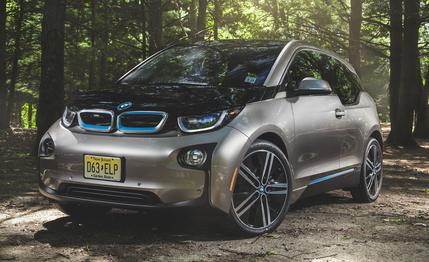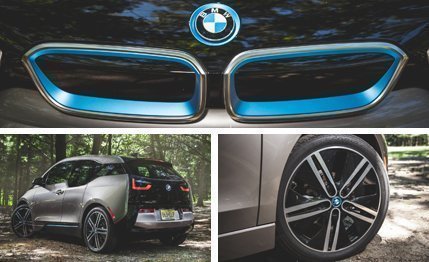
 Instrumented Test
Instrumented Test
The automotive future according to Hollywood exists as one of two polar-opposite scenarios. Either it’s sleek and bright, filled with fast-moving pods gliding over flawless, uncongested roads, or it’s dark and dystopian, with kludged trucks and muscle cars roaming dilapidated and desolate highways. Hollywood never dreams of roads jammed full of frumpy electric hatchbacks, but the BMW i3 suggests that’s our more likely automotive future.
The BMW i3 with its optional range extender is steeped in forward-thinking technology. Look past the tall, stubby hood and you’ll find an aluminum skateboard chassis driven by an electric motor, augmented by a two-cylinder gasoline-fueled “range extender” engine, and topped with a carbon-fiber passenger cell skinned in composite panels. The materials, the powertrain, and even the awkward design all point to a future of smarter and more efficient cars.
If, like us, you’ve noticed that BMW’s traditionally sporty sedans are getting soft around the belly, the i3 might convince you that the Bavarians have now swung to the opposite extreme, still eschewing athleticism but now adopting a Fair Trade, locally sourced, Whole Foods outlook on building cars. The drive-mode chassis-adjustment selector here tops out at Comfort and the closest the i3 comes to a Sport+ mode analogue is Eco Pro+, a self-inflicted driving purgatory where top speed is limited to 56 mph and the climate-control system blows only unconditioned air from the outside. Around the skidpad, tires barely wider than an adult hand manage just 0.80 g of lateral grip with the undefeatable stability control nipping at the brakes. But while it’s difficult to wrap your head around the i3 as a BMW, it makes perfect sense as an ambassador for the future of driving.


With a fully charged battery, the i3 drives much like electric competitors from Nissan, Ford, and Chevrolet. Quiet and smooth, it steps off the line with the confident low-rpm torque shove of an electric motor. But there’s one big difference in how you drive the i3. In keeping with automotive tradition, BMW installed two pedals at the driver’s feet, but it’s possible to drive the i3 using only the right one. When you lift off the accelerator, the i3 initiates a regenerative braking scheme that converts kinetic energy into electricity to extend the range. That wouldn’t be particularly notable, except that the BMW decelerates so quickly and consistently at all speeds that the regenerative braking can slow the car all the way to a stop. As long as you keep your eyes up and traffic doesn’t slow abruptly, you can negotiate the roads solely by manipulating the accelerator. This writer made the 20-mile commute home—across town, on a highway, off an exit ramp, into a neighborhood, and up a driveway—using only the right pedal. This aggressive regenerative-braking strategy also means that the left pedal can be dedicated to slowing the i3 via conventional hydraulic binders, making for a solid, progressive pedal feel. When called to the task, those brakes can haul the i3 to a stop from 70 mph in as little as 160 feet.
One cautionary note here: One-pedal driving activates the brake lights during sharp deceleration (exceeding 0.13 g), but our two-pedal experience creates expectations that may not align with one-pedal reality. It would seem wise, even if otherwise unnecessary, to depress the left pedal and illuminate the brake lights to give following drivers fair warning, particularly when approaching a full stop and at rest.


At 3135 pounds, the range-extender-equipped i3 is almost 300 pounds heavier than the pure-electric model, yet despite lugging around a second powertrain, the aluminum-and-carbon-fiber construction still gives the range-extended BMW a 200-pound advantage on the pure-electric Nissan Leaf. Flat-pedal acceleration propels the i3 to 60 mph in 7.0 seconds and through the quarter-mile in 15.8. That’s quick, especially considering that this is a segment in which many cars need 10 seconds to hit the mile-a-minute mark.
At low speeds, the i3 warbles and whoop-whoop-whoops in a way that reminded several staffers of George Jetson’s flying car. (A YouTube refresher reveals that the glass-domed cartoon saucer emitted a higher pitch playing at a more spastic frequency than the BMW.) The audio track is intended to warn pedestrians of the i3’s otherwise near-silent approach, but it can occasionally be heard inside the car, an endearing reminder that you’re driving The Future.
The strongest hints of BMW are found in the handling feel. The steering is quick at 2.6 turns lock-to-lock, and there’s an on-center immediacy that would seem natural in a 3-series. Yet on the highway, where semi-truck slipstreams and strong winds sometimes push around the short and light i3, the eager steering requires constant attention and maintenance to keep it from dancing in its lane. The understeer at the limit is moderate—a high compliment considering how front-motor electric vehicles on low-rolling-resistance tires tend to plow; it helps that 54.8 percent of the i3’s weight is carried by the rear axle. The ride is compliant and controlled, although like many of today’s conventional BMWs, it’s slightly underdamped.